Ford finally has a serious electric vehicle in its lineup, and it’s called the Mustang Mach-E. We’re sure you all have plenty of thoughts on the name, but there’s a car to be looked at here, too.
As it stands, there are only so many electric crossovers out there, most of them by luxury automakers. We decided to pick a few of them and do a quick specs comparison. The Tesla Model Y is likely going to be the Mustang Mach-E’s most direct competitor, but that car is still a giant question mark when it comes to specs. However, the Model 3 is not, so we’re using the four-door sedan as a stand-in for now. The Model Y is probably going to have similar specs as the Model 3 — just watch out for a little less speed and a little more cabin space. All of our other competitors line up mighty close to Ford’s new electric crossover, as you’ll see in the chart just below.
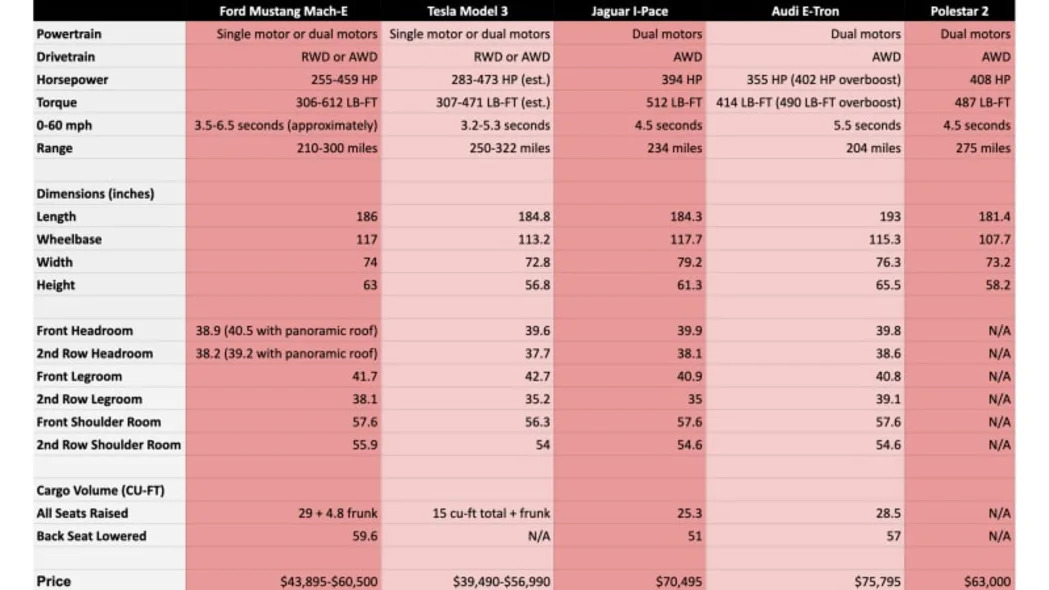
Performance
From a pure numbers standpoint, the 2021 Ford Mustang Mach-E absolutely rocks. The GT makes about 459 horsepower and 612 pound-feet of torque, which is better than every other vehicle in the comparison here. A 0-60 mph time in the “mid three-second range” is also quicker than every vehicle but the Model 3 Performance. So yes, this Mustang will be able to go fast in a straight line when you ask it to.
The lineup offers a range of performance, too. If you don’t need the breakneck speed of the GT, cheaper, slower versions are available. A Mustang that gets to 60 mph in the mid six-second range can be had, as well as a Mustang in the mid five-second range.
Ford also has a great array of options when it comes to total range on a full charge. The maximum-range car will have a 98.8 kWh battery pack targeting 300 miles of range using EPA testing. A standard range Mach-E Select will have as little as 210 miles of range, while everything else is somewhere in between. The quick GT takes a big hit in the range department, with its estimates all the way down at 235 miles as a result of the extra power. Still, only the Model 3 is able to challenge the Mach-E when it comes to the maximum range, boasting 22 miles more on a full charge. The I-Pace and E-Tron are in the low-to-mid 200s when it comes to total range, while the Polestar 2 has 275 miles. This puts the E-Tron and I-Pace on par with some of the lower-range Mach-Es, but the 300-mile-plus range cars handily win this comparison and are still cheaper.
Utility
Despite the Mustang’s fastback looks, it’s shockingly utilitarian. None of the competitors in this comparison can touch it in cargo space, especially after the large 4.8 cubic-foot frunk is taken into consideration. The E-Tron gets close in cargo space behind the seats, but with only 2.1 cubic feet of space in the frunk (mostly taken up by the charger) it falls behind the Ford.
Passenger space is another win for Ford, but we’ll have to revisit this upon hearing official Model Y numbers. There’s tons more backseat legroom in the Ford than the Model 3 and I-Pace, and it almost edges out the much larger E-Tron, too. Thank the Mach E’s considerably long wheelbase for this interior room. Ford appears to have gotten the packaging right, even with the slick body lines. With the panoramic roof option, it even has more rear headroom than all of its pseudo competition. One noticeable feature we’ll point out is the black-painted roof. It simulates a lower roofline to the eye, but the roof itself isn’t as intrusive on interior space as other coupe-like crossovers have been.
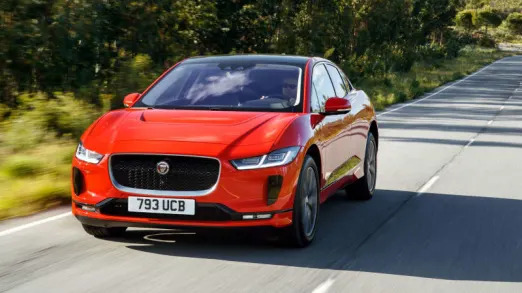
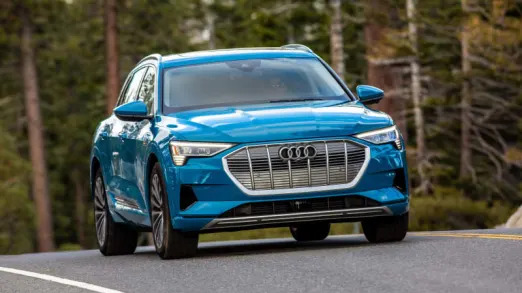
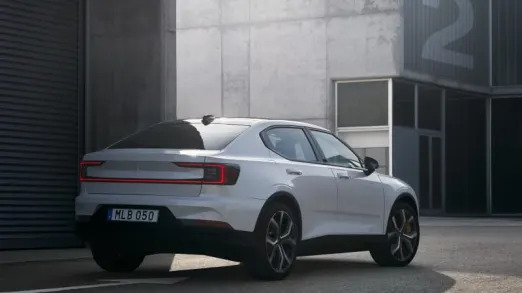

Pricing
Here’s where the Mach-E gets really enticing. Comparing it to luxury EVs isn’t exactly a fair fight, but there’s nothing else with similar performance to compare to. The Hyundai and Kia EVs are all front-drive with much less horsepower, and the Nissan Leaf isn’t even on the same playing field.
The 2021 Ford Mustang Mach-E starts at a base price of $43,895. That’s before an unknown destination charge is tacked on, and it’s also before the $7,500 federal tax credit is taken advantage of. A Model 3 is cheaper at $39,490, but you don’t get the full $7,500 tax credit with that car anymore. The Model Y is on track to be a fair bit more expensive than the Model 3, making the Mach-E even more enticing.
If you want more than 210 miles of range, you’ll have to pay for it. The 300-mile California RT.1 Edition is a hefty $52,400, and a Premium with all-wheel drive and 270 miles of range is $58,300. The GT will start at $60,500 when it eventually goes on sale in 2021.
All of these trims are still cheaper than the Audi, Jaguar and Polestar, making it a relative performance bargain. The interior isn’t as nice as the luxury cars’ interiors, but it still looks like a fresh and modern place to be in. It’ll be up to folks shopping to choose what their priorities are in an electric crossover. From a performance perspective, the Ford is either on-par or better than many of the more expensive luxury crossovers. There’s no doubt the Audi, Jaguar and Polestar have nicer interiors than the Ford in terms of materials used and quality, but the Ford has the utility.
It’s a tough fight, truthfully. Go ahead and hate the Mustang crossover for its name or its styling. But it’s impossible to take anything away from the car’s performance chops as an electric crossover. We’re excited to slide behind the wheel to see if it’s able to do the Mustang name proud.
Note: A previous version of this article misstated some of the specs for the Polestar 2. It has been updated with the correct information.
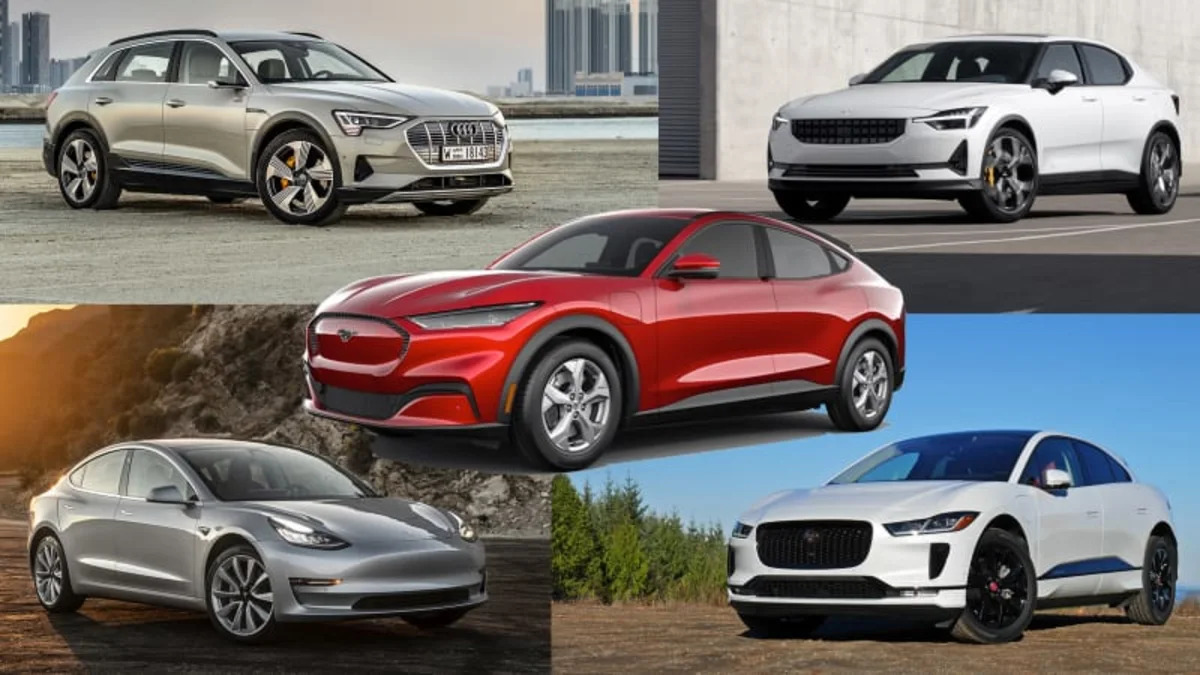


Sign in to post
Please sign in to leave a comment.
Continue